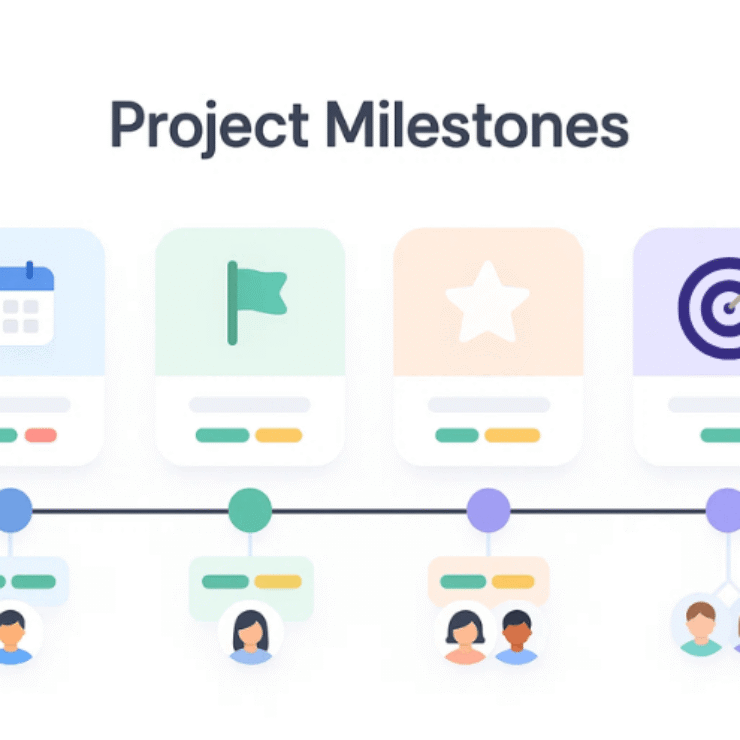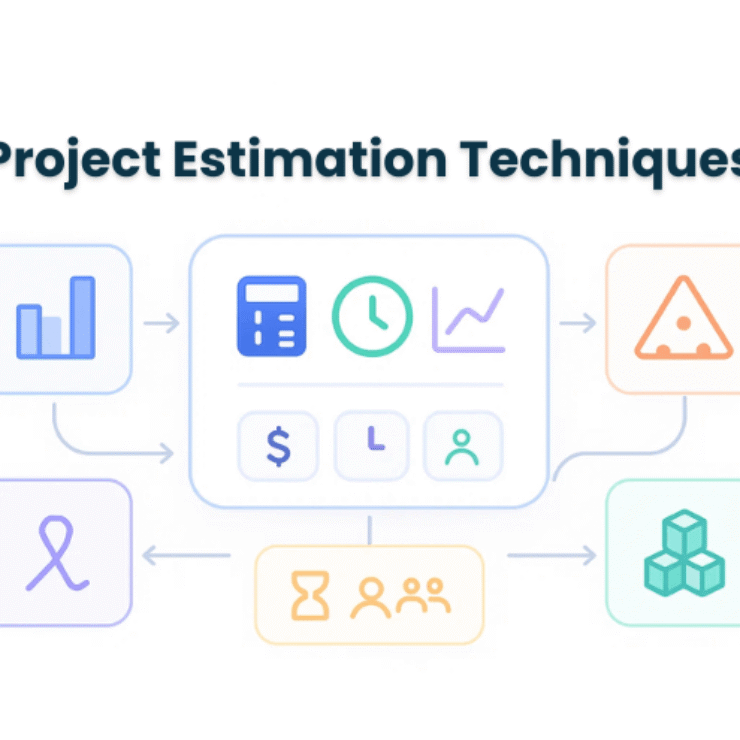Introduction
If you’ve ever managed a project that started small and somehow exploded into something unrecognizable, don’t worry — you’re not alone. Scope creep is one of the biggest reasons projects derails. And after leading enterprise and cross-functional projects for 15+ years — across IT, marketing, and large transformation programs — I can confidently say this: Successful projects are not about working harder — they’re about managing scope smarter.
Here’s the thing: according to PMI, 52% of projects experience scope creep, and Gallup reports that only 2.5% of companies deliver 100% of their projects successfully. Poor scope definition and weak change control are the biggest contributors.
In this guide, I’ll Walk you through project scope management in a practical, real-world way — with processes, templates, examples, and tips you can use immediately.
What Is Project Scope Management? (And Why It Matters More Than People Realize)
Project scope management is the discipline of defining what the project will deliver, what it won’t deliver, and keeping everyone aligned throughout execution.
Most project headaches come from misalignment, not technical issues. And as someone who has seen dozens of projects derail due to unclear boundaries, trust me — scope management is your best insurance against chaos.
Clear scope management helps you:
- Prevent rework and confusion
- Avoid budget overruns
- Align stakeholder expectations
- Keep timelines predictable
- Prevent “surprise” tasks
- Make confident decisions when change requests appear
According to PMI, 47% of unsuccessful projects fail to deliver on their goals because of inadequate requirements management. This makes one thing very clear: solid scope management saves time, money, and credibility.
Core Building Blocks of Project Scope
1. Project Scope Statement
A scope statement defines:
- What the project will produce
- What’s included
- What’s excluded
- Major deliverables
- Constraints & assumptions
- Success criteria
A good scope statement prevents 80% of misunderstandings.
2. Work Breakdown Structure (WBS)
This is where scope becomes visual. A WBS breaks the project into:
Deliverables → Sub-deliverables → Work Packages → Tasks
It gives teams clarity like nothing else.
Real-life insight: In one of my large implementation projects, creating a detailed work breakdown structure (WBS) reduced rework by nearly 40%, because everyone finally had the same understanding of what ‘done’ looked like.”
3. Scope Baseline
Your scope baseline = Approved Scope Statement + WBS + WBS Dictionary
Once approved, this becomes the reference for every future discussion, change evaluation, and status update.
Project Scope Management Processes (Simplified & Practical)
PMI lists six formal processes — but let’s make them simple and practical.
1. Plan Scope Management
Define:
- How scope will be documented
- Who approves changes
- Which templates you’ll use
- Review cadence
Output → Scope Management Plan
2. Collect Requirements
This step is where most projects succeed or fail.
Use:
- Workshops
- Interviews
- User stories
- Prototypes
- Observations
- Surveys
- Benchmarking
According to the Standish Group’s 2020 CHAOS data, nearly 66% of software projects fail or get challenged, often due to poor or shifting requirements. This underlines why rigorous scope and requirement management is essential.
3. Define Scope
Convert requirements into a clear scope statement:
- In-scope
- Out-of-scope
- Constraints
- Assumptions
- Dependencies
- High-level acceptance criteria
This becomes your first line of defense against scope creep.
4. Create WBS
Break the project into small, manageable pieces.
A clean WBS = better estimates, clearer responsibilities, fewer surprises.
5. Validate Scope
Formal acceptance from stakeholders through:
- Walkthroughs
- Demos
- Milestone reviews
- Sign-offs
This prevents the classic “But I thought this included that…” scenario.
6. Control Scope
This process runs throughout the project:
- Compare actuals vs baseline
- Evaluate change requests
- Assess impacts (scope/time/cost/resources)
- Accept or reject changes
- Update documentation
Great scope control = predictable delivery.
How to Create a Project Scope Management Plan (Step-by-Step)
A strong scope management plan gives you structure and confidence.
Step 1: Define Objectives & Success Criteria
Don’t just list tasks — tie scope to business outcomes.
Example:
❌ Build a marketing landing page
✔ Increase demo requests by 20% with a CRO-optimized landing page
Step 2: Draft the Scope Statement
Include:
- Project background
- Objectives
- In-scope items
- Out-of-scope items
- Deliverables
- Constraints
- Assumptions
- Risks
Step 3: Build the WBS
Break work into clear deliverables and work packages.
Example WBS for a website redesign:
- Discovery
- Content
- UI/UX design
- Development
- QA
- Launch
Step 4: Define Roles (RACI Keeps It Simple)
Clarify:
- Who can approve scope
- Who must review
- Who performs tasks
- Who gets informed
This avoids decision bottlenecks.
Step 5: Establish Change Control
Every change request should answer:
- What changed?
- What does it impact? (scope/time/cost/resources)
- Should we re-baseline?
- Who approves it?
Use a simple change request form + log.
Step 6: Set Scope Review Cadence
Weekly or biweekly scope checks prevent silent creep.
Scope Creep: Causes, Examples & How to Stop It Before It Starts
Scope creep is sneaky — and extremely expensive if ignored.
What Is Scope Creep?
Uncontrolled growth in project work without adjusting deadlines, budget, or resources.
Common Causes
- Vague scope
- Verbal approvals
- Gold-plating by team members
- Hidden stakeholder expectations
- No out-of-scope section
- No change control
Real-Life Scope Creep Example
“In one of my early enterprise projects, five ‘small design tweaks’ turned into a two-month delay because nobody evaluated their impact formally. Everyone assumed someone else approved it.”
This is more common than most teams admit.
Early Warning Signs
- “It will take just 5 minutes.”
- Team doing extra work quietly
- Frequent re-estimation
- Milestones slipping
- Stakeholders changing requirements mid-sprint
Spot these early → prevent collapse later.
How to Prevent Scope Creep
- Define out-of-scope clearly
- Document all changes
- Do impact analysis for every request
- Get written approval
- Maintain a change log
- Review scope frequently
How to Fix Scope Creep
- Re-baseline
- Renegotiate deliverables
- Adjust priorities
- Reset expectations
- Communicate impacts clearly
Project Scope Management Templates
1. Scope Management Plan Template
- Purpose
- Roles & responsibilities
- Scope statement summary
- WBS overview
- Baseline
- Change control process
- Review cadence
2. Scope Statement Template
- Background
- Objectives
- Deliverables
- In-scope
- Out-of-scope
- Constraints
- Assumptions
- Risks
3. WBS Template
Download: WBS Template
4. Scope Change Log Template
| ID | Description | Requester | Impact (S/T/C) | Decision | Updated Baseline |
Project Scope in Agile, Hybrid & Waterfall
Waterfall
- Scope fixed early
- Good for structured, predictable work
- Heavy documentation upfront
Agile
- Scope evolves over time
- Backlog drives work
- Focus on outcomes, not fixed deliverables
Hybrid
- Best of both worlds
- High-level scope fixed, details flexible
- Ideal for large, evolving projects
Project Scope Management Examples
1. Software Implementation
Clean scope + strong change control = smooth rollout.
WBS example: data mapping → integration → testing → deployment.
2. Marketing Project
Scope covered creative, digital, media, analytics.
New channel (podcast ads) came as a change request → evaluated → approved → baseline updated.
3. Construction Project
Highly formalized.
Every change requires documented change orders and cost impact.
Expert insight: “From my experience leading IT + marketing launches, defining an out-of-scope list upfront eliminated 90% of misunderstandings later.”
Common Mistakes in Scope Management
- No out-of-scope list
- Saying “yes” to every request
- Skipping WBS
- Verbal approvals
- Not maintaining a change log
- Not revisiting scope at milestones
Best Practices for Better Scope Management
- Tie scope to outcomes, not tasks
- Keep documentation simple but clear
- Do frequent scope reviews
- Socialize the scope with all stakeholders
- Use visuals like WBS diagrams
- Maintain a lightweight change control workflow
Tools for Project Scope Management
Look for tools that support:
- Scope documentation
- WBS creation
- Version control
- Change request workflows
- Dashboards & reporting
Examples include Karya Keeper, Jira, Monday.com, ProjectManager, and ClickUp.
Final Thoughts
Scope management is not about controlling people — it’s about creating clarity. When everyone knows what’s in, what’s out, and how changes will be handled, projects stop drifting and start delivering.
In my 15+ years leading cross-functional projects, one pattern has been consistent: clear scope upfront prevents chaos later. The teams that define boundaries early, validate expectations often, and manage change intentionally are the ones that hit their timelines without burnout or surprises.
Use the processes and templates in this guide as your structure. Review scope frequently, document decisions, and keep communication transparent. Do that — and your project will stay aligned, controlled, and predictable, no matter how complex it gets.
FAQs
Plan Scope, Collect Requirements, Define Scope, Create WBS, Validate Scope, Control Scope.
Project scope = work to be done.
Product scope = features of the final product.
Include objectives, in-scope, out-of-scope, deliverables, assumptions, constraints, and success criteria.
Vague requirements, verbal approvals, unclear expectations, and weak change control.
Scope statement, scope management plan, WBS, baseline summary, change log.



